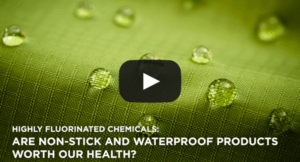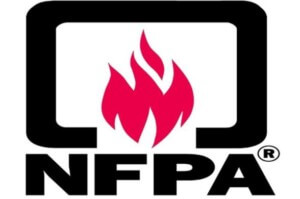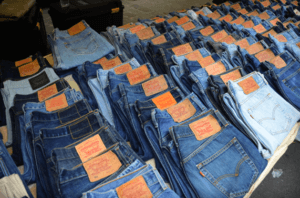March 2018: Farewell to Forever Chemicals?
In this edition:
- Are flame retardants coming back to your couch?
- Greener Blue Jeans
- Does your TV case contain toxic flame retardants – that can end up inside you?
- EU Strategy for a Non-toxic Environment

When it comes to highly fluorinated or “Forever Chemicals,” only using them when they are truly essential is so much easier than trying to clean them up after they are contaminating our drinking water and ecosystems. An example of a safer alternative is one of the first outdoor jackets without these chemicals in the fun short video on the right. And now other outdoor manufacturers are also offering clothing with alternative waterproof treatments!
At the Emerging Contaminants Summit earlier this month, I had the opportunity to address 500 engineers and scientists about preventing the use of these highly persistent chemicals. One major source of the contamination is firefighting foam used during training military and civilian airports. Outside the US, many airports are moving to effective fluorine free alternatives. We are working with staff on the Hill to encourage the U.S. military to do the same and allow the use of safer alternatives when appropriate.
Our congratulations to Toxic Free Future and Washington State for banning the use of all highly fluorinated chemicals in fire-fighting foam and also in paper food packaging — two important firsts! And to California for proposing to list carpets and rugs containing any of these chemicals as priority products for regulation under Safer Consumer Products rules. This proposal came a week after our Highly Fluorinated Chemicals in Carpeting Information Exchange workshop, which brought together large purchasers, manufacturers, and others along the supply chain to develop strategies for healthier carpeting without any “Forever Chemicals.”
Carpets are children’s major source of exposure to highly fluorinated chemicals and we plan to study their transfer from carpeting to dust to children. If there is wall-to-wall carpeting in your home or your child’s nursery school, and you live in the San Francisco Bay Area, you are invited to participate in our upcoming study of highly fluorinated chemicals in home and nursery school carpeting. Please write me or [email protected] to participate and learn whether these chemicals are present. We thank you in advance for your possible participation.

You can learn more about highly fluorinated chemicals and how to reduce your own exposure by viewing our four-minute video to the left and reading Liza Gross’s new article “In search of safe replacements for harmful chemicals used in cookware, carpets, clothing, cosmetics and more”. You can view the PPT talks from our February 2018 “Highly Fluorinated Chemicals in Carpeting Information Exchange” workshop here and from our Flame Retardant and Beyond Symposium at UC Berkeley here.
Finally, you might enjoy my new and improved www.ArleneBlum.com website with memorable photos from my mountain expeditions worldwide that you can freely enjoy and download.
Have a happy spring,
Arlene and the Green Science Policy Team
Are flame retardants coming back to your couch?

In 2013, California updated its furniture flammability standard so that toxic flame retardants were no longer needed in our nation’s furniture. This removed pounds of harmful chemicals from our homes– a boon for our health.
Shockingly, a new standard (NFPA 277) is under development at the National Fire Protection Association (NFPA) that could lead to even higher levels of flame retardants in home furniture than were used before. Although NFPA standards are voluntary, they tend to be widely adopted. Plans to roll out this new standard have continued despite a lack of need for such a standard and objections from scientists, purchasers, manufacturers and consumers who all want healthy safe furniture without toxic flame retardants.
On March 21, the NFPA’s Fire Test Technical Committee voted 14-3 to move NFPA 277 to the Standards Council. If approved by the Standards Council, NFPA 277 could be cited by state and local fire codes and become a de facto requirement for upholstered furniture across North America. This could bring pounds of cancer-causing, endocrine-disrupting flame retardant chemicals back into our homes with a questionable impact on fire safety.
The NPFA process on this standard is troubling with representatives of the public interest mostly excluded. If you are concerned, please send a message to Jim Pauley, CEO of the NFPA, to express your opposition to NFPA 277 and support for healthy furniture without toxic flame retardants.
Greener Blue Jeans

Designers at Levi Strauss & Co. are using a surprising new tool to create the oh-so stylish wear patterns that are a hallmark of their blue jeans: lasers. While traditional denim-finishing requires a laundry list of bleaches, peroxides, enzymes, acids, lubricants, wetting agents, and softeners; the new process produces a vintage look by using lasers to burn away thin layers of fabric and dye. Levi’s expects the technique, known as Project FLX, to reduce the number of chemicals used in jeans production from thousands to just a few dozen! The technology is a key piece of the company’s strategy for eliminating its discharge of all hazardous chemicals by 2020.
In addition to being better for worker health and the environment, the lasers cut the amount of time needed to finish a pair of jeans from about ten minutes down to just 90 seconds. It just goes to show that sometimes the best replacement for a harmful chemical is not another chemical.
Levi’s is also one of a growing number of apparel companies to phase out the use of highly fluorinated chemicals. Kudos to Levi’s!
Does your TV case contain toxic flame retardants – that can end up inside you?

US manufacturers have been adding flame retardants to the plastic enclosures around televisions for decades in spite of their toxicity and lack of proven fire safety benefit. These harmful chemicals can leach out into household dust which we pick up on our hands, and then ingest when we touch food before we eat it. For the last decade our Institute has led successful science-based efforts to prevent new regulations leading to hundreds of millions of pounds of toxic and unneeded flame retardants in television and other electronics cases worldwide each year. However the toxic TV problem has not been solved.
A recent Washington state study found flame retardants in 11 out of 12 plastic television cases tested. Other troubling results include:
Banned chemicals: Two of the TVs contained decabromodiphenyl ether (deca-BDE), which has been banned in electronics by the EU and in five US states. This includes Washington State where the TVs were purchased.
Chemicals of high concern: Eight other TVs contained flame retardants of high concern
High concentrations: In seven of the TVs, these chemicals were found in concentrations over 20% by weight of the enclosure. One enclosure was a staggering 33% flame retardant.
New chemicals of concern: Most companies are using a mix of flame retardants, including a relatively new one called TTBP-TAZ, which contains a hormone-disrupting chemical impurity.
Stopping new standards that would lead to the need for flame retardants in electronics cases without improving fire safety may be our most challenging and important project. Learn more about flame retardants and how to reduce your own exposure at www.SixClasses.org and read the full report from Toxic Free Future and Clean Production Action: TV REALITY: Toxic Flame Retardants in TVs.
EU Strategy for a Non-toxic Environment

Guest entry from Gretta Goldenman, Chair of our Board
From 2004 to 2014, global chemicals sales more than doubled, and growth is expected to continue by 4% every year. These increases make it harder to limit our exposure to harmful chemicals, and concern is mounting over the costs of health effects and loss of natural resources.
Against this backdrop the European Union recently published a report entitled Study for the strategy for a non-toxic environment of the 7th Environment Action Programme, prepared by Belgian consultancy Milieu with the support of colleagues. The report reviews how the EU’s chemicals regulatory framework is the most stringent in the world, yet problem areas remain, including lack of information concerning chemicals in articles, especially imported articles, and exposure of children and other vulnerable populations. The study points out the importance of restricting and phasing out hazardous substances in order to prevent them from appearing in waste streams and recycled materials, and endangering the EU’s goal of a circular economy. Highly persistent chemicals such as fluorinated substances could in particular build up and reach harmful levels.
The study argues for more use of grouping approaches such as our Six Classes. This will avoid regrettable substitutions and allow more transparency concerning chemicals in products including articles. It also suggests developing a chemicals management hierarchy, starting with avoiding production and use of harmful chemicals and limiting their uses to situations where exposure does not occur. The report is available here.
Receive Updates By Email
Subscribe to our monthly newsletter and get these updates delivered right to your inbox!